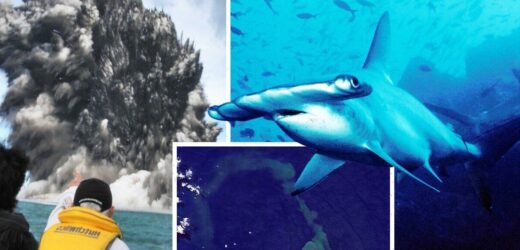Shark left with large scar on skin following ‘mating season’
We use your sign-up to provide content in ways you’ve consented to and to improve our understanding of you. This may include adverts from us and 3rd parties based on our understanding. You can unsubscribe at any time. More info
NASA’s Goddard Space Flight Centre tweeted: “You’ve heard of sharknado, now get ready for sharkcano. The Kavachi Volcano in the Solomon Islands is home to two species of sharks. It’s also one of the most active submarine volcanoes in the Pacific.”
According to the Smithsonian Global Volcanism Program, Kavachi — located some 15 miles south of Vangunu, in the Solomon Islands — entered an eruptive phase last October.
Images taken by satellites including NASA’s Landsat 9 Earth observatory showed the presence of plumes of discoloured water being emitted from the submarine volcano on several days in April and May.
Such plumes of superheated and acidic water typically contain particulate matter, sulphur and particulate matter.
Large eruptions have also been observed coming from Kavachi in 2003, 2004, 2007, 2014 — during which periods visible plumes of smoke and ash have been witnessed coming up from the ocean’s surface.


The volcano is named after a sea god of the people of the New Georgia Islands, and is referred to locally as “Rejo te Kavachi”, or “Kavachi’s oven”.
It formed as a result of tectonic activity in the region — the volcano lies just 18 miles southwest of a subduction zone where the Australian plate is sinking under the Pacific plate, partially melting to release magma that rises back up to the surface.
The lava released by Kavachi tends to be basaltic (rich in iron and magnesium) to andesitic (with higher levels of silica) in content.
The volcano is known for undergoing so-called phreatomagmatic eruptions, in which the interaction of molten rock with water results in explosive eruptions that release a mixture of steam, ash, volcanic rock fragments and incandescent bombs.


Kavachi’s first recorded eruption was back in 1939, and since then the volcano has succeeded in producing ephemeral islands that have subsequently been eroded back into the sea on at least eight separate occasions.
At present, the summit of the volcano lies at a depth of just 65 feet below sea level, while its base sits on the seafloor at a depth of around 0.75 miles.
In 2015, a scientific expedition to the volcano found that Kavachi’s crater played home to a surprising variety of marine life — including both silky and scalloped hammerhead shark species.
The researchers also reported the presence of the sixgill stingray around the crater and various communities of microbes that thrive on the sulphur released from the volcano.
DON’T MISS:
Antiquity’s most powerful armour-piercing bow reconstructed [ANALYSIS]
Ukraine masterplan to ‘immediately’ cut Putin’s support in Russia [INSIGHT]
Scientists baffled as images reveal mysterious ‘continent-sized’ blobs [REPORT]

In a 2016 paper detailing their expedition, the researchers wrote: “Populations of gelatinous animals, small fish, and sharks were observed inside the active crater.”
This, they added, raised “new questions about the ecology of active submarine volcanoes and the extreme environments in which large marine animals can exist.”
Exactly what impact the recent eruption will have had on the shark population that resided on Kavachi remains to be determined — however, given the frequency of the volcano’s eruptions, it is likely that the sharks, if displaced, will return soon.
The full findings of the 2016 study were published in the magazine Oceanography.
Source: Read Full Article


